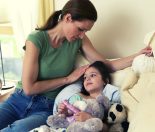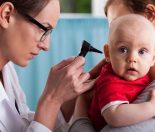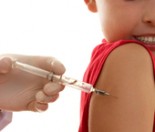This article covers the signs and symptoms of pneumonia, the treatment and the complications that can occur in children with pneumonia.
What is pneumonia?
Pneumonia is an infection of the lungs and respiratory system. It causes inflammation and the normal air sacs of the lungs (alveoli) become filled with fluid.
Pneumonia can range in severity from a mild illness to one that is potentially life threatening. Traditionally it was called `old man’s friends’ because it often brought death in the elderly and infirm.
There are a number of causes of pneumonia including:
- Bacterial infection – which can develop following an upper respiratory track infection like a cold, sore throat or the flu. Bacteria is the cause of 50% of pneumonias, most commonly a streptococcus bacteria known as pneumococcus
- Virus – this tends to happen more in the winter and can be serious in people with heart or lung disease
- Chlamydia – more common in school children. This is a different bacteria than the one that causes the sexually transmitted disease
- Mycoplasma – a tiny bacteria which tends to spread in child care centres and schools
- Pneumocystis carinii – which occurs in people with suppressed immune infections, such as those who are undergoing chemotherapy, have had organ transplants, people with AIDS and those being treated with corticosteroids
- Other causes of pneumonia include fungi, parasites, chemical or physical injury to the lungs, tuberculous, lung cancer, alcohol abuse.
- SARS (Severe Acute Respiratory Syndrome) is a particularly contagious and dangerous type of pneumonia that first occurred in China in 2002.
- Aspiration pneumonia occurs when contents of the stomach have been inhaled into the lungs following vomiting (which is why people passed out drunk need to be watched carefully, so that they don’t vomit in their sleep).
Incubation periods are different depending on what causes the pneumonia but symptoms may begin anywhere from 18 hours to six days after exposure to a bacteria or virus.
Hippocrates, the father of modern medicine who lived between 460 BC and 380 BC, even then referred to pneumonia as being “named by the ancients”.
Signs and symptoms of pneumonia
- Cough – coughing up green or yellow mucous
- Difficulty breathing
- Rapid breathing
- Grunting or wheezing sounds when breathing
- In children – abdominal muscles and muscles around rib cage pulling in and out hard when breathing
- Fever
- Chills
- Chest pain – pain to breath deeply or cough
- Not hungry
- Feeling very unwell
- Abdominal pain
- Chlamydia pneumonia in babies can cause conjunctivitis or pink infected eyes
Bacterial pneumonia
- Symptoms often begin 2 – 3 days after a cold or sore throat
- Child becomes sick quickly with sudden fever and rapid breathing
Viral pneumonia
- Symptoms appear more gradually and are less severe than bacterial pneumonia
- Wheezing breathing sound
As well as the signs and symptoms listed, be aware that in some children the only symptom of pneumonia might be rapid breathing – or just a fever, abdominal pain or vomiting. In some young children it may be that they are just sleepy or have a poor appetite.
Pneumonia in children is also sometimes mistaken as being appendicitis.
A child not getting enough oxygen:
A symptom of a child who isn’t getting enough oxygen into their body will be blue/grey/pale colour around the lips.
The fingernails also show how much oxygen is perfusing the body – blue or grey nails show a lack of oxygen (this is why patients undergoing an anaesthetic are asked to remove nail polish, so the anaesthetist can ascertain oxygen level of the body)
Treatment of pneumonia
- Take your child to the doctor
- The doctor will do a physical exam, listen to the chest with a stethoscope, perhaps order blood tests, a test of mucous coughed up and also a chest x-ray
- Depending on the cause of the pneumonia, the doctor will order appropriate treatment. For example, for a bacterial infection he/she will prescribe antibiotics
- Pneumonia will generally clear within a week or two of beginning treatment
- Hospitalisation may be needed if your child is very sick with a high fever, has trouble breathing or is unable to keep food and fluids down
- Reoccurring bouts of pneumonia need careful investigation
Risks and complications in children with pneumonia
Risk factors:
- Children with long term health problems are at greater risk – for example those with heart or lung problems, diabetes or asthma
- Premature babies
- Being in hospital– especially if your immune system is weak or your are seriously ill
- The very old and very young are at greater risk
- Smoking – smoking coats the cells of the lungs
- Alcoholism
- People who have had their spleen removed
- Those who work with chemicals and solvents or live/work in a polluted environment.
Complications:
- Lung abscesses
- Pleurisy – the membranes around the lungs become inflamed or even infected and may require a drainage tube to be inserted
- Bacteria can spread to the bloodstream – a potentially life threatening situation called sepsis or septicaemia
- Death – left untreated, pneumonia can ultimately cause death (pneumonia is the leading cause of death of children worldwide)
What can I do for my child with pneumonia?
- Stop contagious bacteria or viruses causing pneumonia spreading to others – use good hygiene and keep your child home from school
- Don’t let your child share eating or drinking utensils with others
- Give your child plenty of fluids and an easily digestible, nutritious diet
- Ensure they get plenty of rest
- Take your child’s temperature regularly to ensure it isn’t getting too high
- Ensure the complete course of antibiotics is finished to prevent reinfection with a stronger bacteria
- Don’t smoke around children
- Vaccinations such as those against whooping cough and Hemophilus influenzae may help protect against pneumonia.
Now that you know more about pneumonia, you may want to arm yourself with more expert health advice, see our Common childhood illnesses section.






